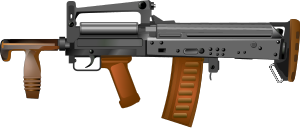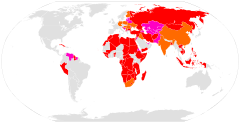| OTs-14 Groza | |
|---|---|
 | |
| Type | Assault rifle |
| Place of origin | Russian Federation |
| Service history | |
| In service | 1994–present |
| Used by |
|
| Wars |
First Chechen War Second Chechen War 2008 South Ossetia War |
| Production history | |
| Designer |
V.N. Telesh and Y.V. Lebedev |
| Designed | 1990s |
| Manufacturer | TsKIB SOO |
| Variants |
OTs-14-4A OTs-14-4A-01 OTs-14-4A-02 OTs-14-4A-03 |
| Specifications | |
| Mass |
2,7 kg (OTs-14-4A-01 and OTs-14-4A-02) 3,6 kg (OTs-14-4A and OTs-14-4A-03) |
| Length |
610 mm (OTs-14-4A) 565 mm (OTs-14-4A-01) 500 mm (OTs-14-4A-02) 720 mm (OTs-14-4A-03) |
| Barrel length |
240 mm (Groza-4) 415 mm (Groza-1) |
| Width |
60 mm (OTs-14-4A without a grenade launcher) 75 mm (OTs-14-4A with a grenade launcher mounted) 70 mm (OTs-14-1A without a grenade launcher) 80 mm (OTs-14-1A with a grenade launcher mounted) |
| Height |
294 mm (OTs-14-4A without a grenade launcher) 266 mm (OTs-14-4A with a grenade launcher mounted) 350 mm (OTs-14-1A without a grenade launcher) 320 mm (OTs-14-1A with a grenade launcher mounted) |
|
| |
| Cartridge |
9x39mm (Groza-4), 7.62x39mm (Groza-1) |
| Action | Gas-operated, rotating bolt |
| Rate of fire |
700 rounds/min (Groza-4), 750 rounds/min (Groza-1) |
| Muzzle velocity |
300 m/s (Groza-4), 720 m/s (Groza-1) |
| Effective firing range |
200 m (Groza-4), 300 m (Groza-1) |
| Maximum firing range |
400 m (Groza-4), 500 m (Groza-1) |
| Feed system |
20-round detachable box magazine (Groza-4), 30-round detachable box magazine (Groza-1) |
| Sights | Iron sights, several optical and night vision sights |
The OTs-14 Groza (ОЦ-14 "Гроза") is a Russian selective fire bullpup assault rifle chambered for the 7.62×39 round and the 9×39mm subsonic round. It was developed in the 1990s at the TsKIB SOO (Central Design and Research Bureau of Sporting and Hunting Arms) in Tula, Russia. The weapon is colloquially known as OC-14 or OTs-14 "Groza" ("Thunderstorm"). The OTs-14-4A "Groza-4" has one derivative, the TKB-0239 (ТКБ-0239), also known as OTs-14-1A "Groza-1", chambered for the 7.62x39mm round.
History[]
Work on the OTs-14-4A project began in December 1992. The weapon's chief designers were Valery Telesh, responsible for the GP-25 and GP-30 under-barrel grenade launchers, and Yuri Lebedev. The team set out to design an integrated system that would incorporate all the best features of a close combat arm into a single weapon using the AKS-74U as a starting platform. Prototypes were ready for testing in less than a year and the weapon was ready for production by early 1994. It was first presented to the public at the MILIPOL Moscow trade show in April 1994 and adopted by the Ministry of Internal Affairs (MVD) shortly thereafter. The success of the OTs-14-4A in the hands of MVD personnel brought it to the attention of the Ministry of Defence (MO), who also had a requirement for such a weapon. After a period of testing, the weapon was adopted for spetsnaz forces and some airborne and specialist front-line combat units such as combat engineers. The weapon was originally intended to have used any one of four cartridges: 5.45x39mm, 5.56x45mm, 7.62x39mm or 9x39mm. That idea was dropped and the assault rifle was originally chambered in 9x39mm to meet the MVD's requirement for a close combat weapon for deployment in Chechnya.
Design details[]
Operating mechanism[]
The OTs-14-4A is a small arms weapon system based on the 5.45x39mm AKS-74U carbine. It is a selective fire, air-cooled magazine-fed rifle with a gas-actuated piston operating system and a rotary bolt locking mechanism.
Features[]
The OTs-14-4A shares a 75% component commonality with the AKS-74U.[citation needed] The basic components of the weapon are borrowed directly from the AKS-74U assault rifle and slightly modified, simplifying the design as a whole and making the weapon considerably cheaper. The weapon has modular design allowing for assembly of one of four weapon versions depending on the assigned mission. It is configured in a bullpup layout for increased portability and balance. The grip is displaced forward, making the assault rifle compact, suitable for concealed carrying and so well balanced that it can be fired using just one hand, like a pistol.
The weapon fires from a closed bolt and has a hammer-type firing mechanism. It has a unitary trigger; a three-position combination fire mode selector switch / manual safety on the left side of the receiver sets whether it fires either the rifle or the grenade launcher or places it in "safe". The assault rifle is equipped with iron sights contained in the carrying handle that consist of an adjustable rear aperture sight on a tangent leaf with range graduations from 50 to 200 m, and a forward post. The grenade launcher is aimed using a folding leaf sight. The weapon will also accept several optical sights, including the PSO telescopic sights which mount directly onto the carrying handle or, as on early models, onto a bracket on the left side of the receiver housing. The OTs-14-4A also has a night sight dovetail that will accept all standard night vision optics.
Accessories[]
It is issued in an aluminum transport case with equipment and accessories for a wide array of tactical situations. Included in the case are two different grip and trigger assemblies, one for use with the modified GP-25/30 grenade launcher and another for use when the launcher is detached. When the grenade launcher is installed, the combined rifle and grenade launcher is operated with a single trigger. A selector switch on left side of the grip near the trigger guard allows the user to select between rifle or grenade barrels. When the grenade launcher is detached, it is replaced by a vertical grip. A suppressor is also included in the standard kit, as is a quick-change short barrel for use with the suppressor or for when maximum compactness is desired.
Variants[]
- OTs-14-1A Groza-1 - Primary model chambered in 7.62x39mm M43 Soviet; it uses the same magazines as the AK-47 / AKM assault rifles. Originally an experimental chambering, it was later adopted by the Army in 1998 for use by its Airborne, Combat Engineering, and Spetsnaz troops. It has more hitting power and range than the subsonic version and can use cheaper ammunition readily available from supplies.
- OTs-14-1A-01 - Carbine Variant with a short barrel and a vertical foregrip.
- OTs-14-1A-02 - Special Carbine Variant with a short barrel threaded for a suppressor.
- OTs-14-1A-03 - Special Sniper Variant with a short barrel threaded for a suppressor and a telescopic sight bracket on the carrying handle / iron sights.
- OTs-14-1A-04 7,62/40 - Grenade Launcher variant with a long barrel and a GP-30 under-barrel grenade launcher.
- OTs-14-2A - Experimental model chambered in 5.45x39mm M74 Soviet. Not adopted due to a lack of hitting power in comparison with the 7.62mm Soviet and 9mm Subsonic models.
- OTs-14-3A - Experimental model chambered in 5.56x45mm NATO. Neither adopted nor put into production due to a lack of interest from the domestic military or the firm's foreign customers.
- OTs-14-4A Groza-4 - Primary model chambered in 9x39mm Subsonic; it uses the same 20-round magazines as the AS Val ("Shaft") assault rifle and VSS Vintorez ("Thread-cutter") sniper rifle. It was adopted in 1994 by the Ministry of the Interior's OMON Special Operations troops.
- OTs-14-4A-01 - Carbine Variant with a short barrel and a vertical foregrip.
- OTs-14-4A-02 - Special Carbine Variant with a short barrel threaded for a suppressor.
- OTs-14-4A-03 - Special Sniper Variant with a short barrel threaded for a suppressor and a telescopic sight bracket on the carrying handle / iron sights.
- OTs-14-4A-04 9/40 - Grenade Launcher variant with a long barrel and a GP-30 under-barrel grenade launcher.
Advantages[]
- Weapon compactness, relatively small weight and bullpup layout provided a good balance and reduced barrel jump.
- It is as reliable as the Kalashnikov assault rifle, as it is based on the same internal design.
- 9x39mm SP-5 and SP-6 subsonic rounds, along with the attachable suppressor, provide very silent shooting.
- Heavy 9 mm bullet (16 g) provides high stopping power and lethality.
- Good accuracy, along with the high damage and penetration of bullets and a decent rate of fire, provides a reliable engagement of the targets in bulletproof vests of third-class protection, and targets behind cover.
- Modular design allows you to convert the complex into an assault rifle, a CQB assault rifle, a grenade launcher and a sniper rifle.
- The 9x39mm rounds' subsonic velocity actually makes them surprisingly viable for CQB situations, and the Groza is no exception.
Disadvantages[]
- Short aiming line make aiming problematic. Curved trajectory of the 9x39mm round makes it difficult to choose the aiming point.
- Bullpup frame causes difficulties with changing of the magazine.
- The 9x39mm Subsonic version has a low capacity 20-round magazine.
- Using of a single trigger for both assault rifle and grenade launcher slows down switching from grenade launcher to assault rifle and back.
- The side-mounts for different optics must be set up additionally.
- Variants without grenade launcher have a shifted gravity center.
- Left-handed shooting is impossible, because of an extractor situated close to the face on the right side of the weapon.
- The gravity center is situated in the pistol grip and loads the right hand, that lessens the accuracy.
See also[]
References[]
- Project "Groza"
- EnemyForces
- Modern Firearms
- Энциклопедия Оружия: Автоматно-гранатометный комплекс ОЦ-14 «Гроза» (Encyclopedia of Weapons: Assault Rifle / Grenade Launcher System OTs-14 Groza ("Storm"))
- Cutshaw, Charlie (1998). The New World of Russian Small Arms & Ammo. Boulder, CO: Paladin Press. pp. 21–26. ISBN 0-87364-993-1.
| |||||||||||||||||||||||||||||||||||||||||||||||||||||||||||||
The original article can be found at OTs-14 Groza and the edit history here.
